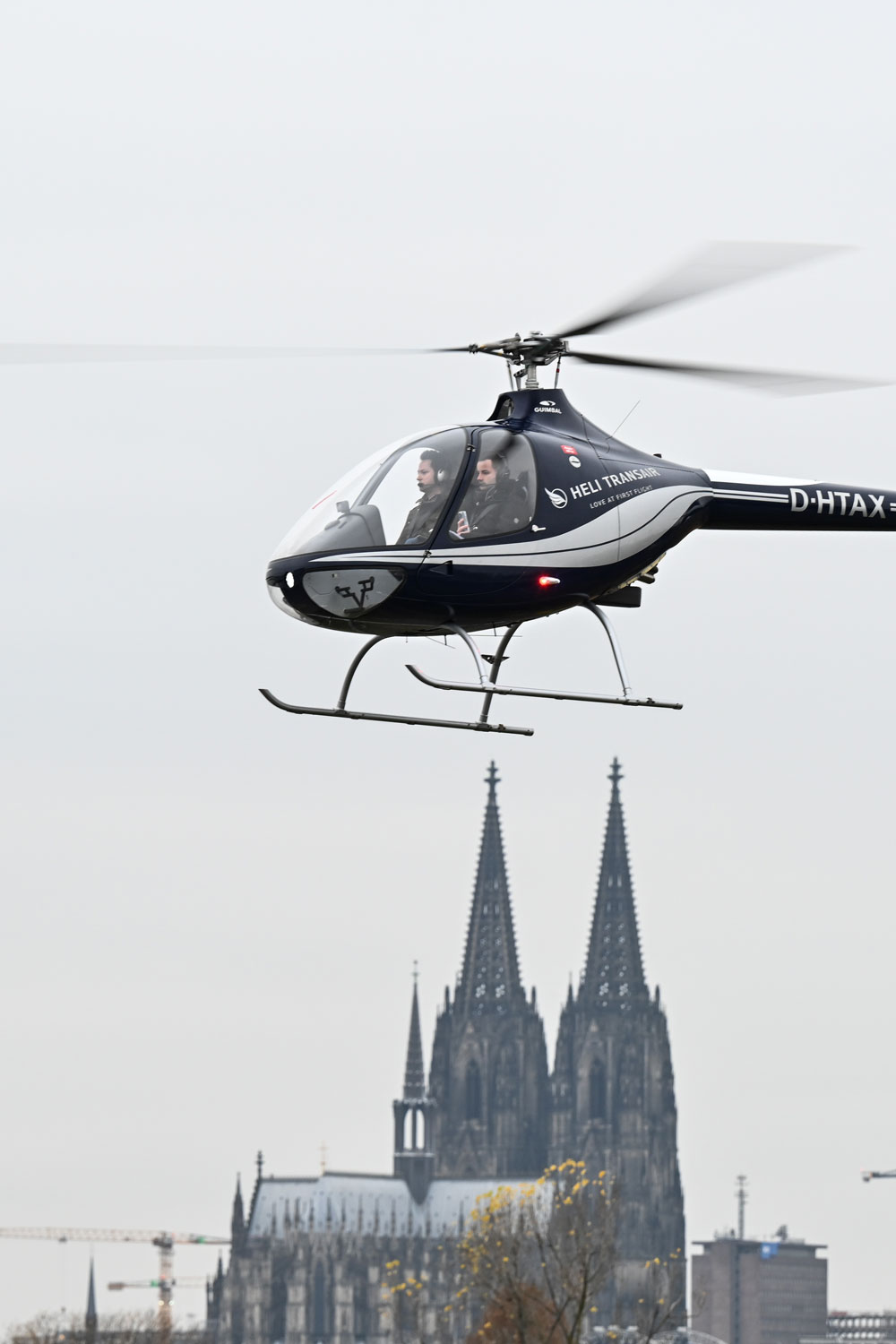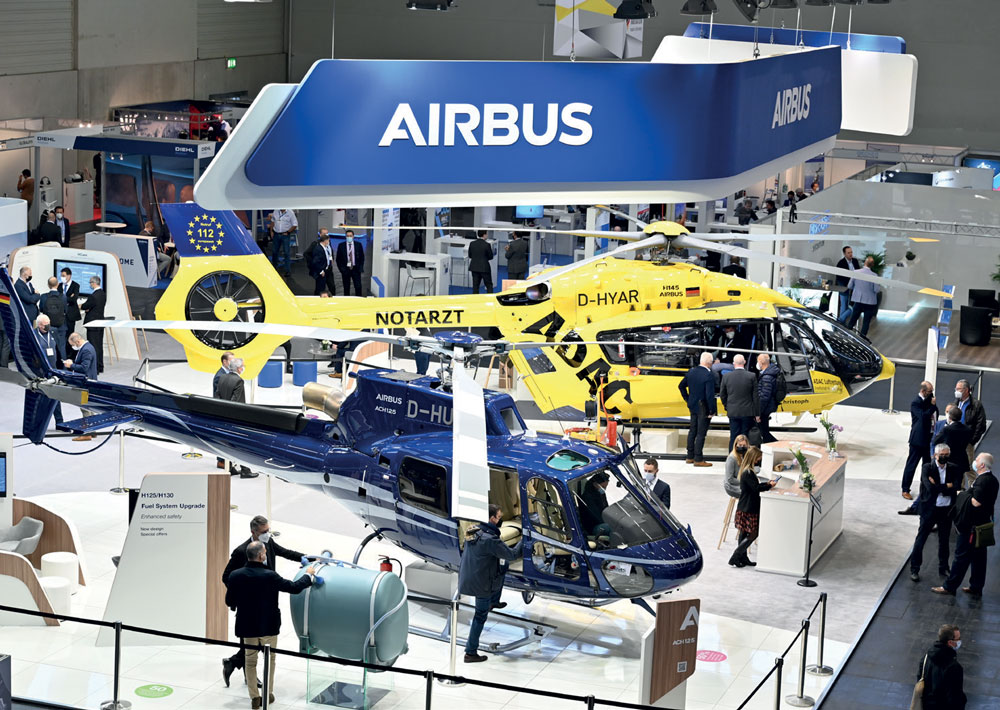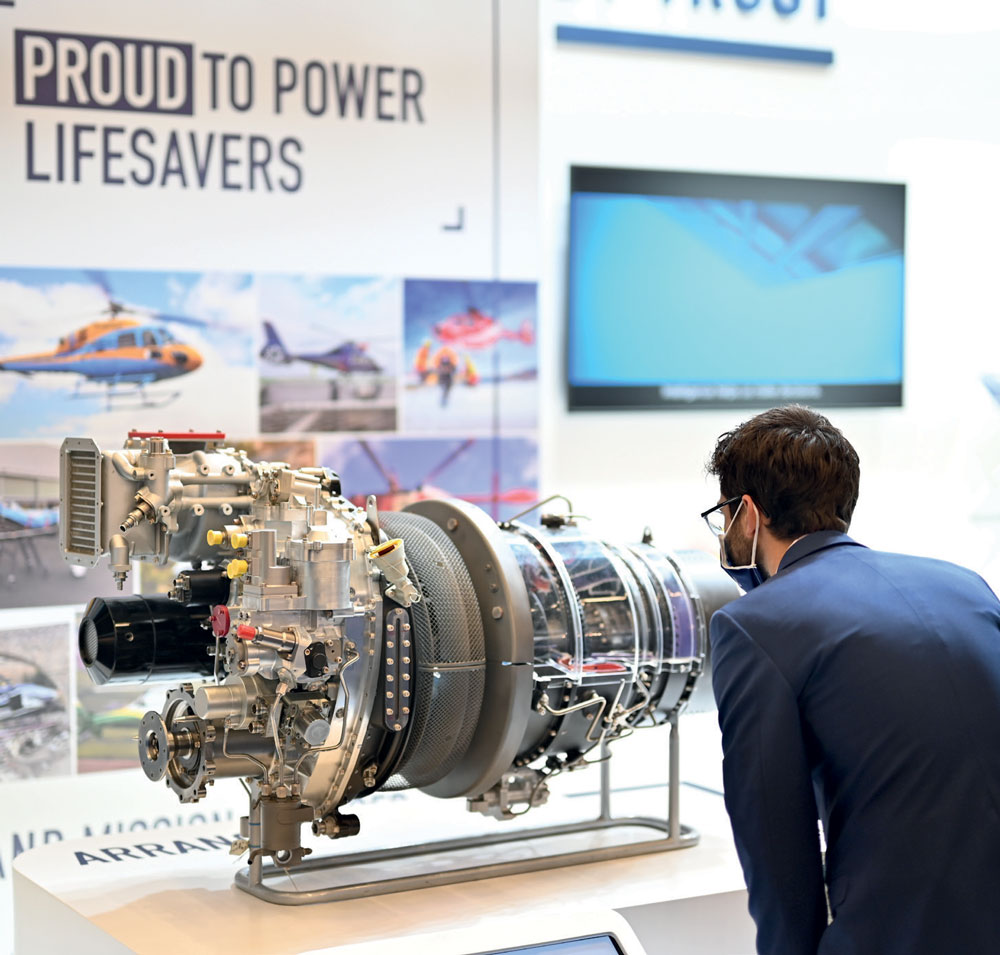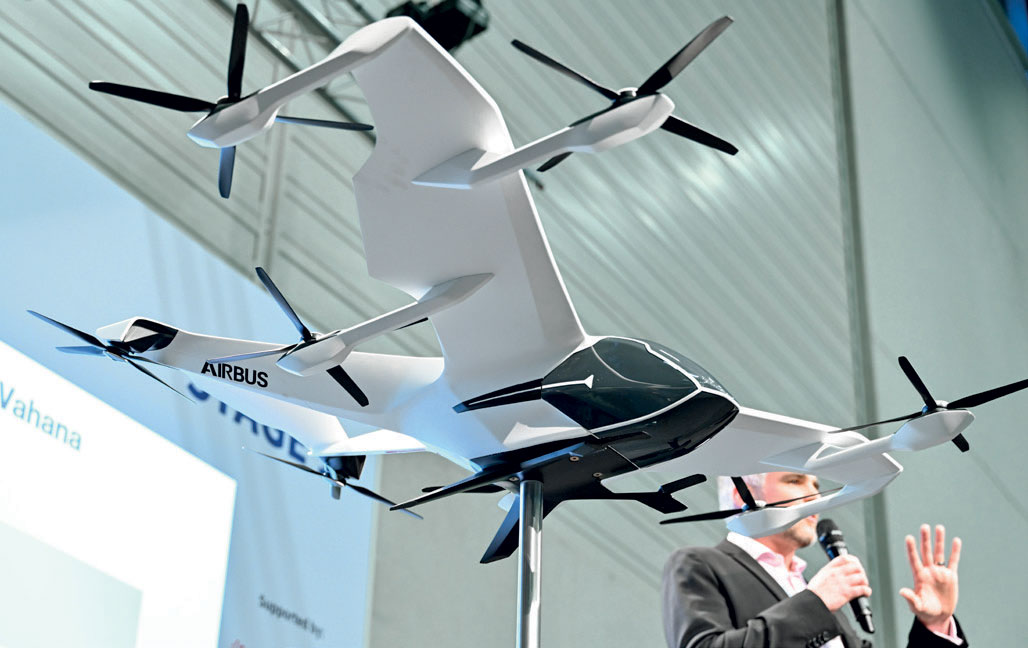ROTORCRAFT European Rotors show
Getting the show back on the road at last
ANDREW DRWIEGA reports from the European Rotors exhibition, held in Cologne, Germany.
 Guimbal Cabri G2 was demonstrated at European Rotors.
Guimbal Cabri G2 was demonstrated at European Rotors.
The Covid-19 pandemic has hit every sector of the economy over the last two years, some harder than others. However, during one of the first exhibitions to open up last year, European Rotors in Cologne, Germany (16-18 November 2021), you could almost hear the collective sigh of relief as the industry could exhibit once more, hold in-person customer sales meetings and stage educational themed briefings to visitors.
Although it was being held at the same time as the Dubai Airshow, and international travel was still restricted by national vaccination and quarantine requirements globally (which inevitably hit numbers), the general feeling among exhibitors was very positive.
It was also the first event held as a joint venture between the European Helicopter Association (EHA) and the European Union Aviation Safety Agency (EASA) – with the Helicopter Association International also represented.
As well as the floor exhibits, there were three special stages at one side of the hall that delivered presentations and discussions during the three days of the show.
On the first day, Patrick Ky, the executive director of the EASA, said during his keynote speech at the opening of the event that one positive result of the pandemic was that: “HEMS (helicopter emergency medical service) was able to play a role that undoubtably saved lives.
This reinforced the importance of the HEMS service.” He also said that the organisation was now: “three years into the EASA rotorcraft safety roadmap, a ten year plan aimed at improving overall rotorcraft safety by 50%.”
Speaking about air taxis, he said: “manufacturers tell us that air taxi services can become a reality by the mid2020s”. He said that, in a survey his organisation had conducted involving around 6,000 EU citizens in six cities on the subject of urban air mobility in November 2020, 83% had a positive response to UAM (urban air mobility) with 71% ready to try out such services (air taxi or parcel delivery).
Surprisingly, in addition to issues regarding cyber security and noise, they expressed concern about the impact on wildlife. Safety standards also hit the high standards imposed on all other areas of aviation.
Several of the main rotorcraft manufacturers were in attendance with floor exhibits. Airbus showed its five-bladed H145, owned by German air rescue service ADAC Luftrettung, together with its own Airbus Corporate Helicopters ACH125.
 The Bell stand offered the Bell 505 owned by MountainFlyers helicopters of Switzerland, and a Bell 429 law enforcement demonstrator which featured German company Elektroniksystem- und Logistik’s (ESG) Mission Management System. The Bell 429 type passed 500,000 fleet flying hours in early January 2022 from a global operating base of over 400 units.
The Bell stand offered the Bell 505 owned by MountainFlyers helicopters of Switzerland, and a Bell 429 law enforcement demonstrator which featured German company Elektroniksystem- und Logistik’s (ESG) Mission Management System. The Bell 429 type passed 500,000 fleet flying hours in early January 2022 from a global operating base of over 400 units.
During the event in Cologne, Bell announced a five helicopter deal with its representative, Heliclub Ukraine, for two Bell 505s, two Bell 429s, and one Bell 407GXi for customers inside the country. After the event in December, a further announcement revealed that two of its Bell 505s had been delivered to the Indonesian Navy (TNI-AL) as basic training helicopters.
 The Airbus stand displayed a five-bladed H145 (yellow) and an AHC125 (blue). European Rotors
The Airbus stand displayed a five-bladed H145 (yellow) and an AHC125 (blue). European Rotors
Leonardo displayed its Emden-owned AW169 in an offshore wind configuration, according to the Company’s Vice President of Marketing, Paul de Jonge van Ellemeet. The offshore wind market is showing signs of positive growth through the increasing focus on sustainable power and is likely to take up some of the shortfall now being experienced in the oil and gas market.
During the pandemic, this market took a significant hit from petrol sales and the huge drop-off in the airline passenger business and, as one European exhibitor candidly stated, there had been ‘up to a 30% reduction in flying hours’ undertaken during the worst times of the Covid-19 pandemic.
The first customer for the AW169M, was the military version of the Italian Army. Since 2020 it has had two UH-169B variants that are being used to train crews for the arrival of a new AW169M variant specific to the Italian Army, the AW169 LUH (Light Utility Helicopter). There is an initial requirement for 15 units.
Although there was not much mention of the AW609 tiltrotor at European Rotors, it was actually being displayed for the first time outside Europe at the Dubai Air Show.
Leonardo has stated that it has required a comprehensive set of new rules set by the US Federal Aviation Administration (FAA), rules which will become the basis of the FAA’s new Powered Lift Category. An expected date for certification has not yet been revealed, except that it should be sometime during 2022.
“We see the light at the end of the tunnel, having flown approximately 1,700 test flight hours and having our final production-representative prototype flying,” said a Leonardo spokesperson. “The programme is in its industrialisation phase with the first two production aircraft on the assembly line, a new building for the final assembly and a comprehensive range of support and training services already available at our Philadelphia manufacturing facility and Training Academy.”
 The Safran stand.
The Safran stand.
Matteo Ragazzi, Senior Vice President Engineering at Leonardo, told AEROSPACE that what had happened to the research and development departments during the pandemic was the opposite trend to what happens normally. Investment went up, although it was moderated by the general slowdown in business across the whole industry sector.
However, this meant that production engineers had more time to spend developing their own projects and, perhaps more importantly, helping others across the global organisation. As it was not a time when new people could be recruited, Leonardo made use of its talent pool on a more international basis than normal.
“Think about us being spread in six geographical areas – Italy, UK, the US, Poland, Kopter in Switzerland and Germany, so engineers can now work together through the enterprise network.
When some locations had less work due to their local order book and conditions, such as the Polish office at one point, they were able to assist their Italian, British and American colleagues by contributing extra remote support when it was needed. So they received work packages delivered to fit the competencies that they had in each region.
“The acquisition of the Swiss independent Kopter Group by Leonardo on 8 April 2020 has brought to the larger organisation the AW09 single-engine light helicopter with much potential”, said Ragazzi.
Taking over the development of the only single light helicopter has merged the new thinking of the engineers who were already working with Kopter (the majority of whom had previously been rotorcraft engineers in other companies), with the power and muscle that a large organisation like Leonardo can bring to the development and testing process.
It is expected that the AW09 will have its entry into service sometime during 2023. The main configuration has now been established, although minor adjustments may still be applied, if required. Currently, the third prototype is conducting testing while a fourth prototype will be ready for its first flight during 2022. “We have already explored the flight envelope, both in terms of airspeed and altitude up to the limits foreseen for the first certification,” said a Kopter spokesperson.
Interestingly, there is already a roadmap to transition from a conventional single turbine helicopter to a hybrid version. The thought is that “the electrical engine can be either used as a back-up power unit (ie hybrid for safety) or as a power boost in a specific mission segment (hybrid for performance). The implementation will be based on a trade-off analysis, considering available battery energy and power density, required electrical power, battery weight and endurance in electrical mode,” stated Kopter.
News on the new Airbus Racer high-speed helicopter demonstrator was that, predictably, there has been a slowdown in the timeline caused by the pandemic. However, build of the prototype was transferred last year from the company’s facility in Donauworth, Germany, to Marignane in the south of France where it is undergoing final assembly. The flight campaign is now scheduled to take place during 2022.
 The AW09 Kopter in flight. Leonardo
The AW09 Kopter in flight. Leonardo
Airbus maintains that it is targeting missions that not only require vertical take-off and landing (VTOL) but also speedy travel times when time is more critical, such as in search and rescue, emergency medical services and personnel transfer in the oil and gas industry. Combining to service all these requirements, it blends together the efficiencies of fixed wings for lift, propellers for propulsion and main rotor for VTOL.
Airbus states that its venerable H125 (previously AS350 Écureuil), currently holds 70% of the market share in its segment. Its performance upgrades to Safran Arriel 2D engines have been certified by both EASA and the FAA. The company states that ‘its external and internal load-lifting capabilities are increased for a large part of the flight domain (by up to +140kg), while the hover ceiling out of ground effect (OGE) at maximum take-off weight is increased by more than 1,500ft (up to 12,600ft).’ The maximum take-off weight is unchanged.
In terms of military milestones, the HForce H145M is fully certified (qualified) and in-service in both Serbia and Hungary. Serbia has received nine helicopters with potential further orders to come in the next year, according to Serbian President Aleksandar Vu›i›, who commented in December 2021. In the summer of 2018 Hungary ordered 20 HForce H145s from Airbus, with the first three upgraded to the HForce configuration by the end of 2020.
 Volocity from Volocopter.
Volocity from Volocopter.
The H145’s new five-bladed rotor increased the useful load by 150kg. Airbus said that the price for the new H145 is ‘in the same region as the four-bladed H145.’
Since the close of the European Rotors expo, Airbus has received good news for its H160 with the announcement that the French Armament General Directorate (DGA) has signed a contract for the development of the H160M as its Light Joint Helicopter (HIL). This stipulates the development of several prototypes with deliveries of the first 30 rotorcraft (21 for the army, eight for the navy and one for the air force) at the beginning of 2027. The DGA has proposed that its requirement is for an order total of 169 H160M helicopters (or Guépard as it will be known in the French armed forces).
According to Airbus, there were around 40 other orders for the H160 at the end of 2020, with launch customers in each segment of oil and gas transportation, EMS, private and business aviation, search and rescue, law enforcement, and military. The EASA type certificate was awarded in July 2020 and the company is currently working with the FAA to gain its certification which is expected soon, as work has continued, despite the difficulties in organising face-to-face meetings that the pandemic has imposed on the programme.
The H175 at the end of 2021 had logged over 100,000 flight hours across a global fleet of 50 aircraft, operating in 11 countries. Airbus reported that the super medium and heavy helicopter market has been ‘difficult’ due to its repression during the pandemic and as the push to replace fossil fuels gathers pace globally. However, there are a good number of older helicopters that will, nevertheless, need to be replaced as the sector is still a very large one and Airbus sees an opportunity here for its new generations, such as the H175.
 Left: An AW169 at the Leonardo stand. Right: At the Bell booth, a Bell 429 (blue) and a Bell 505 (red).
Left: An AW169 at the Leonardo stand. Right: At the Bell booth, a Bell 429 (blue) and a Bell 505 (red).
Franck Saudo, Chief Executive Officer, Safran Helicopter Engines, said that his company had remained resilient during the pandemic, although this had involved “streamlining our organisation, and reducing our cost base.” He said that order cancellations were received in 2020 which showed in deliveries in 2021 which were 15% lower than before the crisis.
 Model of the CityAirbus NextGen. All images courtesy of European Rotors unless stated otherwise.
Model of the CityAirbus NextGen. All images courtesy of European Rotors unless stated otherwise.
One noteworthy piece of news from a manufacturer that did not attend European Rotors came from Sikorsky (now owned by Lockheed Martin). The company announced that its S-70M, which is manufactured at PZL Mielec in Poland, had received a certification in the United States for a Restricted Category Special Airworthiness Certificate. This means that direct sales of the S-70M can go ahead for civil customers – but only in the United States. Jason Lambert, vice president of Sikorsky Global Commercial & Military Systems, added a caveat in that the FAA certification would now allow potential discussions with international customers to go ahead, although it would be down to other national aviation authorities to certify in their own countries.
European Rotors will be an annual event and will return to the Koelnmesse in Cologne, Germany, on 8-10 November 2022. From 2023, however, Peter Moeller, Chairman of the EHA, stated that it would be taken ‘on the road’ around Europe with periodical visits back to Germany.